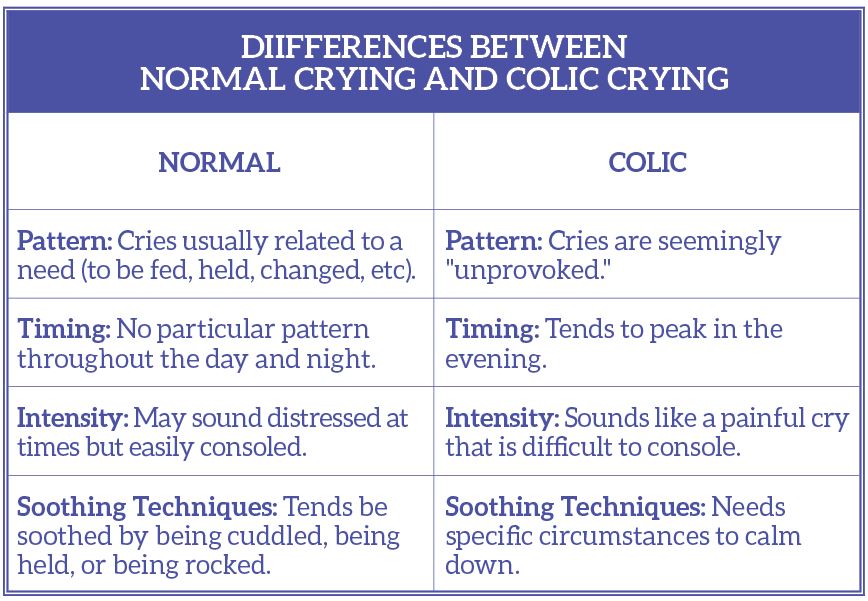If your baby seems to be crying more than usual, despite you ensuring he’s fed, changed, and comforted, chances are, he may be experiencing something called colic. It’s said that one in every five babies will experience it between the first few weeks of their life till about four to six months. Colic is an exasperating yet common condition characterised as excessive crying or extended and repeated periods of crying or fussing in babies who are otherwise healthy and thriving. Read on…
Colic affects both baby boys as well as baby girls equally. The most telling sign of colic is crying and it’s most likely to begin in the late afternoon or early evening although they can occur at any time of the day or night.- Whilst all babies do cry from time to time, a baby with colic will show signs and symptoms including periods of crying or ‘fussing’ almost continuously. A baby may appear to be in pain and may have a flushed or reddened face.
Possible causes
To date, experts have not come to any concrete conclusions as to what causes colic in babies and why symptoms vary from baby to baby. However, it is thought that it may be related to a baby having difficulties with digestion, or taking in too much air while feeding, leading to pressure in the tummy. Success rates of pharmaceutical products and treatments for colic have not been very consistent, for they seem to work on some babies and provide little or no relief to some others.
Colic isn’t harmful
Although parents may worry about their baby being in pain, colic is not a condition that is harmful to their baby’s health and it leaves no long term effects either. All colicky babies will continue to feed and gain weight normally.
What can parents do?
Currently, there is no cure for colic, so the next best thing for parents to do is to try and soothe their affected baby. It’s important that parents who are dealing with a colicky baby remain calm and gathered so as to not lose control over the (sometimes stressful) situation. If needed, take turns with a partner or friend in carrying and soothing a colicky baby. Exchanging opinions and experiences with other parents may also be helpful, for they may have tried other ways and it may work for you too.
Carrying your baby around with you in a sling can provide a close body-to-body contact that is comforting for your little one. Parents with colic babies have also found that warm baths can be soothing and distracting too. Others find that reducing the stimulation in their little one’s environment helped to calm them down.
It is possible that colic is caused by your baby having difficulty in digesting milk, or by taking in too much air while feeding, which then creates uncomfortable pressure in the stomach. Check your baby’s feeding bottle if you’re using one and ensure that it has an anti-colic bottle nipple. Babies who are bottle-fed can be ‘winded’ after a feed to help them bring up any air they take in with the milk; an upright position and gentle pressure on the stomach or patting on the back is helpful. For babies who are breastfed, ensure they are well-positioned at the breast, and finish the milk in the first breast before moving to the second.
Some babies are found to have cow’s milk protein intolerance, where conditions improved when they stopped taking cow’s milk. For formula-fed babies, a change to one that’s hypoallergenic may help.
Could excessive feeding be the cause?
Dr Sears, a world-renowned expert on babies shared that feeding too much, too fast, can increase intestinal gas from the breakdown of excessive lactose, either in mother’s milk or in the formula. As a rule of thumb, feed your baby twice as often and half as much. The logic behind this is that a baby’s tummy is around the size of his fist. To appreciate the discrepancy between usual feeding volume and tummy size, place your baby’s fist next to a bottle filled with four to six ounces of formula or breastmilk and you’ll get the idea of why that tiny tummy gets tensed.
It’s not anyone’s fault
Oftentimes the cause of your baby’s cries cannot be found. You need not feel that it’s your fault if your baby cries a lot. Colicky cries not only pierce tender hearts; they may also push anger buttons. If you think that your baby’s escalating cries are getting to you, hand your little one over to another person or put him safely down and walk out of the room until those feelings subside. In some cases, counselling, reassurance and empathetic support from health professionals have also been shown to help parents cope with the distress and concern caused by a frequently crying baby.
Colic usually subsides by the fourth month
In one study of fifty colicky babies, the evening colic disappeared by four months in all the infants. It was found too, that around that time, babies develop a more internal organization of their sleeping patterns. Other exciting developmental changes also lead babies to the promised land of the fuss-free living: They can see clearly across the room. Babies are so delighted by the visual attractions that they forget to fuss. They also start to play with their hands and engage in self-soothing finger sucking.



